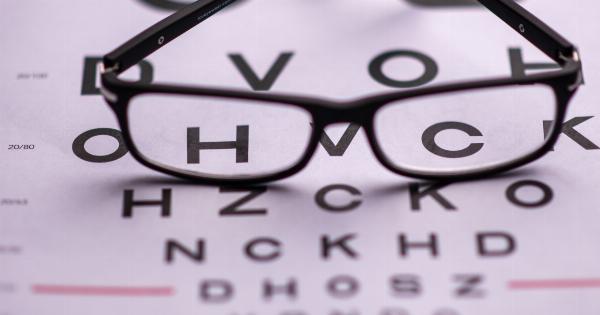Do you often experience itching, burning, or a gritty sensation in your eyes? Do they sometimes feel irritated or as if there’s something in them? If so, you may be suffering from dry eye syndrome.
Dry eye is a common condition caused by a lack of adequate tears to lubricate the eyes, leading to discomfort and sometimes even vision problems. But how can you determine if you have dry eye? In this article, we will explore a simple test you can do at home to help you identify if dry eye syndrome is affecting you.
What is Dry Eye Syndrome?
Dry eye syndrome, also known as keratoconjunctivitis sicca, is a condition that occurs when the eyes do not produce enough tears or when the tears evaporate too quickly.
Tears are crucial for maintaining the health of the front surface of the eye and providing clear vision. They help lubricate the eyes, reduce the risk of infections, and wash away debris. When there is an imbalance in tear production or quality, the result is dry, irritated, and uncomfortable eyes.
The Importance of Identifying Dry Eye
Identifying dry eye syndrome is essential as it can significantly affect your quality of life. The symptoms associated with dry eye, such as redness, itchiness, and eye fatigue, can be bothersome and even impact your ability to perform daily tasks.
Dry eye can also lead to more severe eye conditions, including corneal ulcers, conjunctivitis, and even vision loss if left untreated. Consequently, recognizing if you have dry eye and seeking appropriate treatment is crucial for maintaining your ocular health.
The Schirmer’s Test
One of the most widely used tests for diagnosing dry eye syndrome is the Schirmer’s test. This simple and non-invasive test measures the quantity of tears that your eyes produce. You can even perform this test at home following these easy steps:.
Step 1: Gather the Materials
To perform the Schirmer’s test, you will need the following materials:.
- A ruler
- A sterile Schirmer’s test strip (available at pharmacies or your eye doctor’s office)
Step 2: Preparation
Wash your hands thoroughly before starting the test to avoid contaminating the test strip or your eyes. Open the Schirmer’s test strip package just before performing the test to maintain its sterility.
Step 3: Find a Comfortable Position
Sit or stand in a well-lit area where you can comfortably tilt your head back and still access your eyes easily.
Step 4: Place the Strip
Hold the Schirmer’s test strip by the tapered end, with the numbered side facing up. Gently place the tapered end in the outer corner of your lower eyelid, right where the eyelashes meet the lid.
Step 5: Close Your Eyes and Wait
Close your eyes gently, ensuring the strip is secure inside your eyelid. Keep your eyes closed and avoid any excessive blinking for about five minutes. This allows the test strip to absorb your tears.
Step 6: Remove and Measure the Strip
After five minutes, carefully remove the test strip from your eyelid. Place it on a clean surface and locate the numbered scale printed on it. Measure the distance from the tapered end to the last moist spot on the strip using the ruler.
This measurement indicates how many tears you produced during the test.
Interpreting the Results
The results of the Schirmer’s test can help determine if you have dry eye syndrome. The normal range for tear production is typically between 10 and 20 millimeters over five minutes.
If your tear measurement falls below this range or you experience significant symptoms of dry eye, it is recommended to consult with an eye care professional for further evaluation and treatment options.
Other Diagnostic Tests for Dry Eye
While the Schirmer’s test is a reliable indicator of tear production, there are other diagnostic tests available to assess dry eye syndrome:.
- Fluorescein and lissamine green staining: These tests evaluate the health of the cornea and conjunctiva by using dye to highlight any irregularities or damage.
- Meibomian gland evaluation: This test examines the functionality of the meibomian glands, which are responsible for producing the oily component of tears.
- Tear osmolarity testing: This test measures the saltiness or concentration of tears, as elevated tear osmolarity is a common feature of dry eye.
- Corneal topography: This test creates a detailed map of the cornea’s surface, allowing for the identification of irregularities and abnormalities.
Prevention and Treatment for Dry Eye
Preventing and managing dry eye syndrome involves various strategies, depending on the underlying cause and severity of the condition. Some measures you can take to alleviate dry eye symptoms include:.
- Using artificial tears or lubricating eye drops to supplement natural tear production.
- Avoiding environments with dry air, smoke, and wind, which can exacerbate dry eye symptoms.
- Blinking regularly, particularly when focusing on screens or performing tasks that require prolonged visual concentration.
- Using a humidifier to add moisture to the air in your home or workplace.
- Wearing sunglasses or protective eyewear to shield your eyes from harsh sunlight, windy weather, and irritants.
If your dry eye symptoms persist or worsen, it is vital to seek professional medical advice. An eye care specialist can provide a comprehensive evaluation and prescribe treatments tailored to your specific needs.
These may include prescription eye drops, punctal plugs (tiny inserts placed in the tear ducts to prevent tears from draining), or in severe cases, surgical interventions.
Conclusion
Recognizing the symptoms of dry eye syndrome and understanding whether you are experiencing this condition is crucial to maintain good eye health and overall well-being.
The Schirmer’s test and other diagnostic exams can help determine if you have dry eye, allowing for appropriate prevention and treatment measures to be implemented. By taking proactive steps to manage dry eye, you can alleviate discomfort and protect your vision from potential long-term complications.




























